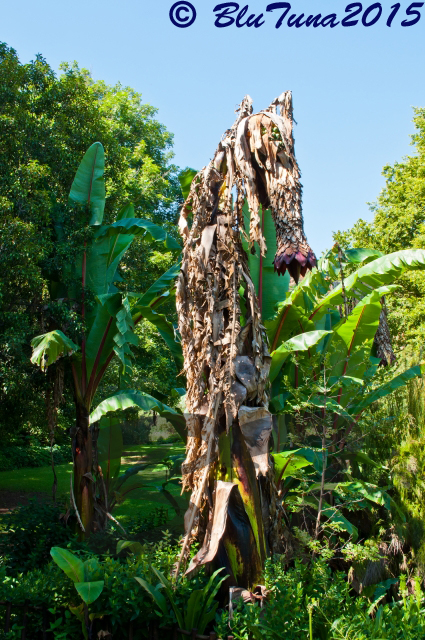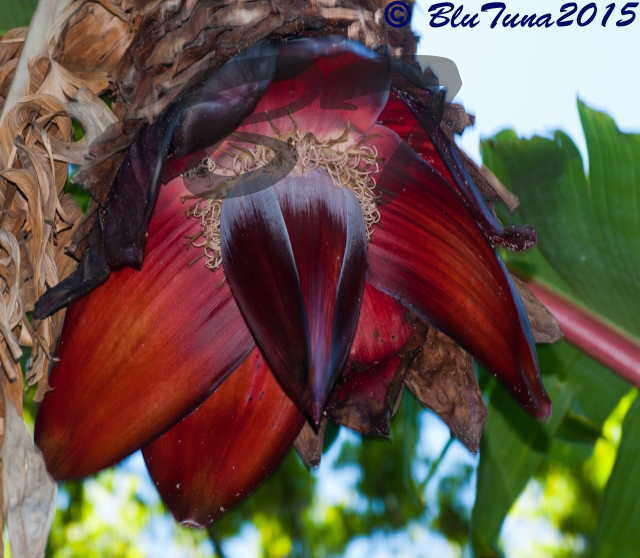Index to Trees and Shrubs in the Order Zingiberales
Family: Musaceae (Banana Family)
031. Ensete ventricosum Abyssinian Banana, False Banana, Wild Banana https://africawild-forum.com/viewtopic.p ... 96#p248296
Africa Wild Tree & Shrub Book - Order Zingiberales
Moderator: Klipspringer
Re: Africa Wild Tree & Shrub Book - Order Zingiberales
031. Abyssinian Banana, False Banana, Wild Banana Ensete ventricosum (Wildepiesang)
Order Zingiberales. Family Musaceae
 © BluTuna
© BluTuna
 © BluTuna
© BluTuna
Walter Sisulu National Botanical Garden, Johannesburg
Description
A large, fleshy-stemmed perennial herb with a head of banana-like leaves. The plant grows between 6 and 12 m high. It is a monocotyledon and does not have a true, branched trunk, but an unbranched pseudostem formed by the imbricated (overlapping) bases of petioles (leaf stalks), left behind when old leaves die. The pseudostem broadens towards the base and this gives rise to the species name ventricosum, which means 'with a swelling'. The plant seldom forms suckers from the base. The simple, large leaves with a thick, rose-pink midrib and numerous pinnately parallel nerves extending to the margin, are spirally arranged. Lamina oblong to oblanceolate-oblong, up to 5 m × 1.5 m, entire, with strongly channelled midrib and many parallel lateral veins, bright to dark green, midrib, petiole and margin sometimes pale to dark red or dark purple, rarely the lower side reddish.
This plant only flowers and bears fruit once and then it dies. The flowers form large, showy bunches or spikes 2 to 3 m in length. The male flowers usually occur at the top and the female or bisexual flowers lower down. The cream-coloured flowers have only one petal, but are surrounded by large, showy, maroon bracts. Flowering usually takes place in early summer (October and November). Insipid, banana-like fruits form after flowering. They have a yellow skin with black spots and contain a row of pea-sized, hard, black seeds. Under normal conditions plants flower when they are about eight years old.
Distribution
Ensete ventricosum is widespread in tropical Africa from Ethiopia, through Kenya, Uganda and Tanzania south to Mozambique and South Africa, and west to the Democratic Republic of Congo. The plant is found in the frost-free areas of Mpumalanga and Limpopo in South Africa.
Habitat
It occurs in patches of high rainfall forests, in forested ravines and along streams.
Order Zingiberales. Family Musaceae
 © BluTuna
© BluTuna © BluTuna
© BluTunaWalter Sisulu National Botanical Garden, Johannesburg
Description
A large, fleshy-stemmed perennial herb with a head of banana-like leaves. The plant grows between 6 and 12 m high. It is a monocotyledon and does not have a true, branched trunk, but an unbranched pseudostem formed by the imbricated (overlapping) bases of petioles (leaf stalks), left behind when old leaves die. The pseudostem broadens towards the base and this gives rise to the species name ventricosum, which means 'with a swelling'. The plant seldom forms suckers from the base. The simple, large leaves with a thick, rose-pink midrib and numerous pinnately parallel nerves extending to the margin, are spirally arranged. Lamina oblong to oblanceolate-oblong, up to 5 m × 1.5 m, entire, with strongly channelled midrib and many parallel lateral veins, bright to dark green, midrib, petiole and margin sometimes pale to dark red or dark purple, rarely the lower side reddish.
This plant only flowers and bears fruit once and then it dies. The flowers form large, showy bunches or spikes 2 to 3 m in length. The male flowers usually occur at the top and the female or bisexual flowers lower down. The cream-coloured flowers have only one petal, but are surrounded by large, showy, maroon bracts. Flowering usually takes place in early summer (October and November). Insipid, banana-like fruits form after flowering. They have a yellow skin with black spots and contain a row of pea-sized, hard, black seeds. Under normal conditions plants flower when they are about eight years old.
Distribution
Ensete ventricosum is widespread in tropical Africa from Ethiopia, through Kenya, Uganda and Tanzania south to Mozambique and South Africa, and west to the Democratic Republic of Congo. The plant is found in the frost-free areas of Mpumalanga and Limpopo in South Africa.
Habitat
It occurs in patches of high rainfall forests, in forested ravines and along streams.


